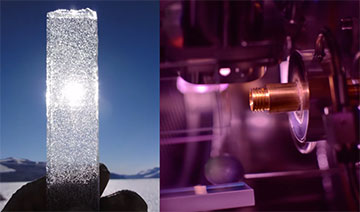
Left: Antarctic ice core and the bubbles contained in it. Right: Vacuum-ultraviolet light source and metastable krypton atom beam device. [Image: Image by Prof. ZHENG’s team]
The field of paleoclimatology studies the climates from past geologic ages, before the invention of meteorological instruments. Similar to the way that paleontologists study fossils to gain insight into the prehistoric past, paleoclimatologists use environmental evidence such as ice cores to reconstruct Earth’s climate history.
Researchers in China and the United States have developed an all-optical method for radiometric dating of ice samples up to 1.5 million years old (Nat. Commun., doi: 10.1038/s41467-025-59264-6). The work gives paleoclimatologists a powerful new tool for analyzing and understanding climate patterns over vast geological periods.
Shrinking the sample size
Krypton-81, produced by cosmic rays in the stratosphere, is known as an ideal isotope for water and ice samples from 30,000 to over 1 million years old. Being chemically inert, krypton-81 provides reliable dating information because its abundance in the environment is not altered by geochemical processes.
Previously, a team led by Zheng-Tian Lu from the University of Science and Technology of China developed Atom Trap Trace Analysis (ATTA), an atom-counting method capable of detecting the extremely low krypton-81 isotopic abundance levels of 10−14 to 10−12 found in environmental samples. ATTA detects single atoms of a particular isotope via fluorescence in a magneto-optical trap. However, it requires too large a sample size—about 100 kg of ice—for recovering paleoclimate information from deep ice cores.
It also significantly extends the age range of krypton-81 dating to an upper limit of 1.5 million years.
In the current study, Lu and his colleagues have developed an all-optical realization of ATTA that allows paleoclimatologists to successfully apply krypton-81 dating on 1-kg ice-core samples. It also significantly extends the age range of krypton-81 dating to an upper limit of 1.5 million years.
Optical excitation
Traditional ATTA is restricted by cross-sample contamination that occurs as a result of a discharge needed for exciting the krypton atoms from the ground to a metastable level, in which laser cooling and trapping can be applied. The researchers replaced discharge excitation with optical excitation, generating metastable krypton atoms via a two-photon transition (124 nm + 819 nm) to a higher-lying intermediate level followed by a spontaneous decay to the metastable level.
The approach reduced sample cross-contamination by two orders of magnitude. Lu and his colleagues tested their system on 1-kg ice core samples from Taylor Glacier in Antarctica, finding that they are approximately 130,000 years old—a value in agreement with independently established stratigraphic alignment, a method that dates ice using contextual information about its different layers.
The researchers are now working with glaciologists both in China and abroad to investigate Greenland ice sheet stability, the development timeline of Tibetan glaciers, and ancient ice that spans the Mid-Pleistocene Transition.

